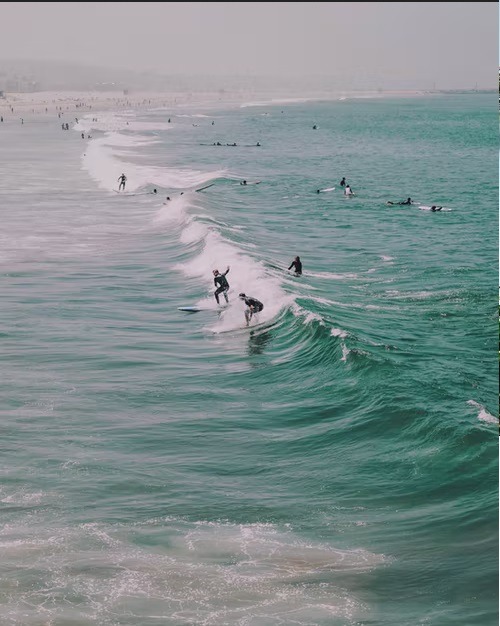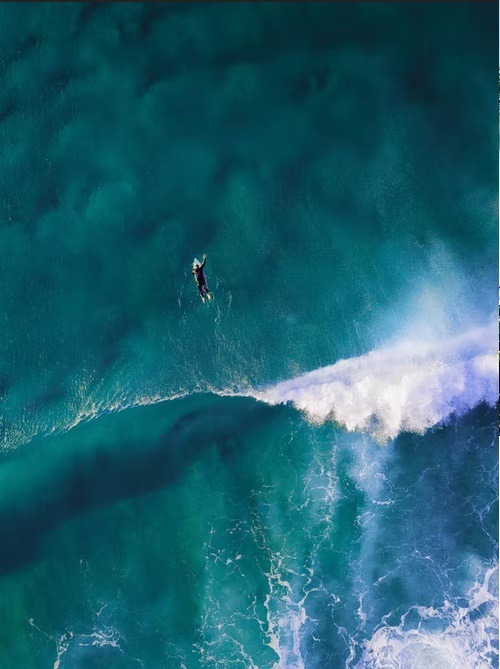Since people started swimming in the ocean, people have likely been riding waves. Bodysurfing is the oldest method of catching waves in this sense. Up to 5,000 years ago, ancient cultures in Peru may have used reed boats for fishing and recreation, according to archeological evidence. The Polynesians made a relatively recent invention by standing up on what is now known as a surfboard. The pre-contact surfers of Hawaii are directly responsible for the influences on modern surfing.
A surfer uses a board to ride on the forward part or face, of a moving wave of water while surfing. The wave usually carries the surfer in the direction of the shore. In addition to standing waves in the open ocean, lakes, tidal bores in rivers, and wave pools, the best places to find waves for surfing are on the ocean shores. Regardless of the stance, riding a wave on a board is referred to as surfing.
Boards come in a variety of varieties. The native peoples of the Pacific region surfed waves on Alaia, paipo, and other similar watercraft, while the Moche of Peru frequently used reed boats. The modern definition of surfing most frequently refers to a surfer riding a wave while standing on a surfboard; this is also known as stand-up surfing. You can search for these boards and all other gears that you require for the sport at S2AS. Ancient cultures frequently surfed on their bellies and knees.
When Did Surfing First Appear?
The history of surfing can be traced back to Polynesia in the 12th century. Ancient surfing scenes have been depicted in detail in cave paintings. Surfing was introduced to Hawaii by the Polynesians, along with many other elements of their culture, and it quickly gained popularity.
Although it is impossible to pinpoint exactly when surfing began, we do know that it did so hundreds of years ago. Ancient Polynesians were at ease in the water, and their culture is closely related to ocean life. The ocean was a vital part of their way of life, whether they were canoeing, swimming, or surfing.
What concrete evidence do we currently have regarding the origin of surfing? The journal of James Cook, a captain from Europe, who saw Tahitian surfers in 1778, is one of the most well-known written accounts of surfing. The sight of men riding the waves on planks of wood startled him and his crew. The diary of James Cook gave readers a wealth of knowledge about navigating the Pacific. But surfing was something the Europeans had never experienced. Even the surfers were a source of concern for them as they were anticipated to be thrown onto sharp rocks close to the shore by the waves.
Where Did Surfing First Take Off?
There is no doubt that surfing originated in ancient Polynesia, and nowhere is this history more well-known than in the Hawaiian Islands. Imagine posing the question, “What is Hawaii famous for? Without a doubt, the most well-liked responses would be beaches, Hawaiian shirts, ukuleles, and surfing. Although most evidence points to Polynesian origins for surfing, there has been some discussion that suggests Pre-Incan civilizations may have invented the sport first. This was later disproved, though, as this watercraft is more like stand-up paddleboards than surfboards.
Surfing was once used by prehistoric Hawaiian tribes as a means of selecting a chief because it requires physical fitness and strength. Athletes now surf for amusement, competitiveness, or professional sponsorship. Back then, if you were able to establish yourself, you could become a ruler.
Who Created the Sport of Surfing?
The ancient Hawaiians did not view surfing as merely a pastime, hobby, extreme sport, or profession like it is today. Instead, the Hawaiians made surfing more of an art form by incorporating it into their culture. The art began before entering the enigmatic ocean as the Hawaiians prayed to the gods for protection and strength to undertake the powerful mystifying ocean. They called it He’s Nalu, which translates into English as, wave sliding. Learn also who invented scuba.
Nevertheless, surfing was such an integral part of Hawaiian culture that it was never completely abandoned. The locals weren’t about to let the Europeans ruin their fun if there were waves to catch. The development of tourism started around the turn of the 20th century, and surfing started to make a significant comeback.
Surfing became increasingly popular, which was great for Hawaiian tourism. People from all over the world began to realize how awesome surfing is. Duke Kahanamoku was one of the most significant early figures in modern surfing. The Duke, who was born in 1890, was one of the greatest surfers of his era as well as a skilled Olympic swimmer.
What Made Surfing Popular?
The popularity of surfing did not develop overnight. A few crucial elements helped surf become a popular sport once it began to take off. Surfing was severely discouraged during the 19th century because of the oppression that European settlers imposed on the Hawaiians. This led to a general lack of enthusiasm for it, and this period is known as the dark age in surfing history. It persisted, though, and people still engaged in it. Additionally, find out more about the best-surfing destinations in the world.
In the late 1800s, Hawaiian tourism began to boom, and many visitors came to the islands to try their hand at surfing. Famous authors like Jack London and Mark Twain even gave surfing a try as interest in it grew. Everyone seemed to be vying for a piece of this thrilling new sport.
Duke Kahanamoku also contributed significantly to the promotion of surfing in Australia and the United States. Around 1960, surfing started to develop into a professional sport as surfers became famous. When the interest in surfing began to increase, it quickly grew into an unstoppable sensation.
Surfing continued to grow in popularity throughout the 1960s because of media coverage. To create music that was all about the surf, sun, and spreading the positive vibes that surfing is so well-known for, bands like The Beach Boys contributed their distinctive sound. The West Coast surf scene grew significantly because of this popularity, and Americans’ fascination with Hawaii only increased. The tourists arrived in waves after Hawaii became a state in 1959 to ride the waves off the Hawaiian coast. From that point on, everything grew correspondingly. Nowadays, surfing is practiced anywhere there is a good wave because it is so widespread. Each year, hundreds of tourists still travel to Hawaii to partake in the sport of surfing in the region where it originated.


